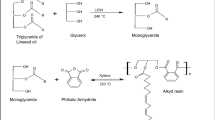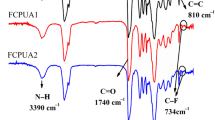Abstract
Water-borne polyurethane (WPU) primers were synthesized from three types of polyol, viz., poly(propylene glycol), poly(tetramethylene glycol), and polycaprolactone diol (PCL) at two prepolymer molecular weights, and were tested for the adhesion between vinyltrimethoxysilane modified aluminum panel and polycarbonate. It was found that chemical hybridizations of Al panel with WPU via sol–gel reaction were crucial to enhance the adhesion. Among three types of polyol, PCL gave the highest adhesion strength, glassy and rubbery moduli, tensile strength, and glass transition temperature. On the other hand, smaller prepolymer molecular weight gave improved adhesion and improved mechanical properties due to the increased crosslink density and cohesive strength.





Similar content being viewed by others
References
Madbouly SA, Otaigbe JU (2006) Kinetic analysis of fractal gel formation in waterborne polyurethane dispersions undergoing high deformation flows. Macromolecules 39:4144–4151
Nanda AK, Wicks DA (2006) The influence of the ionic concentration, concentration of the polymer, degree of neutralization and chain extension on aqueous polyurethane dispersions prepared by the acetone process. Polymer 47:1805–1811
Yen MS, Tsai PY, Hong PD (2006) The solution properties and membrane properties of polydimethylsiloxane waterborne polyurethane blended with the waterborne polyurethanes of various kinds of soft segments. Colloid Surf A 279:1–9
Furukawa M, Hamada Y, Kojio K (2003) Aggregation structure and mechanical properties of functionally graded polyurethane elastomers. J Polym Sci B 41:2355–2363
Hepburn C (1992) Polyurethane elastomer. Elsevier, England
Iyer NP, Gnanarajan TP, Radhakrishanan G (2002) Mechanical and thermal properties of networks prepared from reactive poly(urethane-imide)s and blocked olyurethane prepolymer. Macromol Chem Phys 203:712–717
Kim BK, Lee JC (1996) Waterborne polyurethanes and their properties. J Polym Sci A 34:1095–1104
Noble KL (1997) Waterborne polyurethanes. Prog Org Coat 32:131–136
Jeong HY, Lee MH, Kim BK (2006) Surface modification of waterborne polyurethane. Colloid Surf A 290:178–185
Jeon HT, Jang MK, Kim BK, Kim KH (2007) Synthesis and characterizations of waterborne polyurethane–silica hybrids using sol–gel process. Colloid Surf A 302:559–567
Yang CH, Liu FJ, Liu YP, Liao WT (2006) Hybrids of colloidal silica and waterborne polyurethane. J Colloid Interface Sci 302:123–132
Adler HJ, Jahny K, Bettina VB (2001) Polyurethane macromers-new building blocks for acrylic hybrid emulsions with outstanding performance. Prog Org Coat 43:251–257
Kim BK, Seo JW, Jeong HM (2003) Morphology and properties of waterborne polyurethane/clay nanocomposites. Eur Polym J 39:85–91
Noh SH, Choi HS, Noh ST (2000) Synthesis and application of water-based urethane acrylate crosslinking agent containing unsaturated group. J Appl Polym Sci 78:1216–1223
Schwalm R, Häußling l, Reich W, Beak E, Enenkel P, Mensel K (1997) Tuning the mechanical properties of UV coatings towards hard and flexible systems. Prog Org Coat 32:191–196
Plueddemann EP (1991) Silane coupling agents. Plenum Press, New York
Ooij WJ, Child T (1998) Protecting metals with silane coupling agents. Chem Techn 28:26–35
Digby RP, Shaw SJ (1998) The international collaborative programme on organosilane coupling agents: an introduction. Int J Adhes Adhes 18:261–264
Kim J, Wong PC, Wong KC, Sodhi RNS, Mitchell KAR (2007) Adsorption of BTSE and γ-GPS organosilanes on different microstructural regions of 7075-T6 aluminum alloy. Appl Surf Sci 253:3133–3143
Matienzo LJ, Shaffer DK, Moshier WC, Davis GD (1986) Environmental and adhesive durability of aluminium-polymer systems protected with organic corrosion inhibitors. J Mater Sci 21:1601–1608
Kollek H (1985) Some aspects of chemistry in adhesion on anodized aluminium. Int J Adhes Adhes 5:75–80
Acknowledgment
The research has been supported by National Core Research Center and PNU-IFAM JRC organized at PNU.
Author information
Authors and Affiliations
Corresponding author
Rights and permissions
About this article
Cite this article
Yoon, S.H., Kim, B.K. UV-curable water-borne polyurethane primers for aluminum and polycarbonate interfaces. Polym. Bull. 68, 529–539 (2012). https://doi.org/10.1007/s00289-011-0637-2
Received:
Revised:
Accepted:
Published:
Issue Date:
DOI: https://doi.org/10.1007/s00289-011-0637-2




